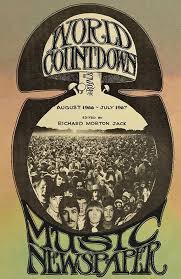The last years of the 1960s saw the emergence of many underground, or at least alternative-ish, papers that gave far more coverage to rock music than almost any prior publications of the short had. Most of them are now forgotten and hard to find; many were very short-lived. Some were so odd in their focus, variable writing style, and rococo graphics that they’re hard to easily describe.
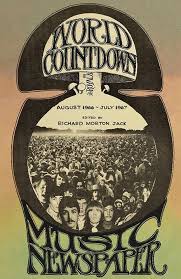
World Countdown, published in California from August 1966 to July 1969, was one such magazine, and one of the hardest to classify. It’s also very hard to find, with few surviving in library or institutional collections, and not many having been preserved by private collectors. Author and rock historian Richard Morton Jack has tracked many of them down, and the new book he’s edited, World Countdown August 1966-July 1967 (on Lansdowne Books), reprints all of them, along with a lengthy introduction covering the history of the magazine.
Original reporting and criticism of the era’s rock scene was not World Countdown‘s forte, although it did have some. Instead, it offered a jumble of reprints of material (ranging from entire articles to bits and pieces) from other magazines; sketchy scene reports and impressions; verbatim reprints of press releases from record labels or publicists hyping specific artists; tons of ads for records, record stores, fashion accessories, music- and fashion-related businesses, and more; and many pictures of music acts from the time, many of them seldom if ever seen elsewhere.
The range of artists covered was almost absurdly wide, from the deepest underground (including quite a few who rarely or never put out records) to the biggest rock superstars, teen pop hitmakers, and even mainstream pop singers. Quite credible early rock journalists could be read in its pages, yet such offerings were outweighed by hype-heavy copy, a good deal of it unattributed. While many of the ads boasted slick professional design, the cut-and-paste layout of many pages could verge on the amateurish.
The obscure pictures and ads are what’s really of most interest, since you really have to sift through the copy to dig out interesting bits of info that rarely surface elsewhere. Some are here, however, like a report on a Fugs concert that mentions their unissued Atlantic album The Fugs Eat It; fleeting bits about Bob Dylan signing to MGM for $2 million (though he’d never record for them) and Capitol considering releasing the Beatles single “A Day in the Life Of” (sic) after the track was illicitly broadcast in advance of Sgt. Pepper‘s release; and Ralph J. Gleason’s accurately enthusiastic review of Jefferson Airplane’s Surrealistic Pillow. Unexpected names pop up among the contributors, like Richard DiLello (before he moved to London and worked for Apple Records) and, as photographer, Ronnie Haran, who helped find acts for the Whisky A Go Go, most notably the Doors.
I asked Richard Morton Jack about the compiling and editing of World Countdown August 1966-July 1967 shortly after the book was published in 2025. Info about the book and purchasing a copy is at https://lansdownebooks.com/products/world-countdown.
World Countdown isn’t well remembered or documented, even by its contributors. How did you find out about it?
A number of years ago I bought an American copy of the (sadly mediocre) album by the Scottish pop group Cartoone, which came out on Atlantic in early 1969. With it was a promo folder containing a copy of World Countdown, with them on the cover. I’d never heard of it and was struck by the amount of information it included about obscure or semi-obscure artists. It was Volume 5, issue 5, so obviously there were other copies out there. I set about trying to find them, but there was almost nothing on the internet about it. I eventually established that a total of fifty-seven issues were published, but to this day few fellow historians or collectors of that period have heard of it, let alone encountered it.
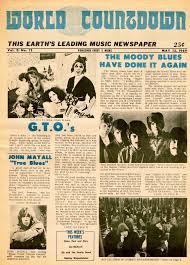
You’ve collected many music magazines from the period. What’s different about World Countdown?
Speaking as a collector, it represents a challenge: it’s easily the most enigmatic music publication of its era that I’m aware of. It appeared in California every fortnight during an extremely exciting and important time in the development of modern pop/rock, yet hardly anyone has ever heard of it or seen a copy, and no library that I’m aware of has more than a couple of issues.
From a broader perspective, it includes photographs and information about some very obscure, in some cases mythologized, artists. These are often straightforward reproductions of record company handouts, rather than original journalism, and – ironically – are more useful to posterity than the self-indulgent ramblings one often finds in underground publications of that era.
What were the biggest challenges in assembling a World Countdown run?
Firstly, I live in England, so the chances of chancing upon it here were negligible (in fact, it has yet to happen). Secondly, I soon realized that, when copies did occasionally surface, other people were bidding hard for them. My main rival was a dealer who seemed to spend his every waking hour patroling eBay, and would snap up practically everything I was looking for before I had seen it. But even he had his limits: one issue with a large image of Jimi Hendrix on the front sold for $750 over a decade ago. I haven’t seen another of those (apart from my own) since.
When I did eventually buy another issue on eBay, I asked the seller if he had more copies for sale and he told me yes, he’d sold the paper on the street himself and did keep a few, which he was happy to sell me for whatever I’d paid for the first one. I happily coughed up and couldn’t wait for the package to arrive. When it did, I found that it contained numerous copies of the exact same issue. Thankfully, I later had a stroke of luck to cancel that out when I managed to track down one of its contributors, who’d kept single copies of various latter-day issues and was happy to sell them to me. Again, to this day I haven’t seen or heard of other copies of most of them.
My other major source of copies was my friend Andrew Sandoval, who’d been buying World Countdown whenever he encountered it for several years, and sent me his entire collection for free when he heard I was trying to get a complete run together. That’s the sort of generous and cool gesture that the best of collectors, like Andrew, often quietly make.
What made you decide to put them into a book?
Having assembled what I assume is the world’s most complete run of the paper, and being convinced of its cultural and historical worth, I wanted to preserve it. It’s no exaggeration to call most issues of it vanishingly rare, so felt that proliferating its contents would be useful as well as entertaining for other serious fans of late 60s music.
In addition, having got to know the children of its late founder and editor, Charles Royal, I knew they were eager to commemorate his work, because he really put his heart into it. They have happy childhood memories of helping him glue it together at home, and of trailing around with him to the Haight or the Fillmore to sell it (because most copies were sold on the street or in dancehalls, not professionally distributed).
You write quite a bit about Charles Royal in the book’s introduction. He was a colorful Englishman who launched numerous odd projects throughout his life. How much of his incentive to run World Countdown do you think was honest enthusiasm for the late-’60s rock scene, and how much was it an attempt to cash in on it?
I’m not convinced that he was a devotee of underground rock per se, but he was undoubtedly a sincere believer in the personal freedom and anti-authoritarianism that the late ’60s promoted (and that psychedelic music encapsulated). He certainly didn’t get rich publishing Countdown: it was poignant and rather amusing to learn from his kids quite how barter-based an enterprise it was. If the family car was dirty, Royal would put an advert for the local carwash in the paper rather than pay. His son Vince vividly remembers selling copies of Countdown at the Monterey Pop Festival in June 1967, and having to heave sackfuls of quarters into the nearest bank at its end. This was not a slick, corporate operation, and meeting the printing bill each month was always a challenge. I’m sure that Royal believed that he was contributing to the general good by producing World Countdown.
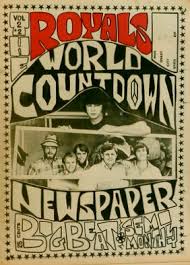
Though much of World Countdown is devoted to press releases, advertising and reprints of material from elsewhere, I think the most valuable parts are the original articles that can’t be found anywhere else. What are the most surprising and interesting of these?
For the paper’s first year, which is what this book contains, it was more of a music-centered collage than a journalistic undertaking, so I can’t point to many particularly important original pieces. One that comes to mind is an early article about the Grateful Dead (so early that Bill Kreutzmann is using the pseudonym Bill Sommers), with first-hand quotes from Jerry Garcia.
In addition, there are adverts, reviews and facts about a range of artists I’ve never seen elsewhere. Clearly, filling each issue without any staff or budget meant that Royal had to be creative, so there are lots of psychedelic graphics – most of them unique to the paper, and some by leading San Francisco artists – some material from other publications, some wonderful photographs that can’t be seen elsewhere, and many press releases promoting obscure acts. To me the latter are especially interesting, because in many cases it seems plausible to assume that Royal inadvertently preserved the only copies posterity would have.
Do you think World Countdown missed opportunities to include more interesting first-hand interviews, concert reviews etc., given its apparent openness to almost anything in the contemporary scene?
I think one has to accept Countdown for what it was in its first year: a freewheeling, eccentric potpourri of whatever material came to hand to meet the next deadline. It would be wonderful, of course, if it had included serious and lengthy interviews from the start, but that simply wasn’t Royal’s modus operandi at the time. However, there are wonderful columns by the prolific and reliably articulate and interesting Derek Taylor, as well as one-offs such as a very long and personal memoir by Jeremy Clyde (of Chad & Jeremy). Such people were personal friends of Royal, and presumably happy to do him the favor of hammering out copy for Countdown.
In the early issues there are also ads for records and other businesses that are unique to the paper: for example, Golden State Recorders, which recorded a lot of mid-’60s San Francisco rock. (Perhaps relatedly, its owner, Leo Kulka, had a column in which he discussed some of these acts.) There’s a full page ad for the Generation that mentions an upcoming Capitol live album, The New Generation. No such record came out. There are also quite a few ads for Dino Valenti concerts, showing how active he was in late 1966 and early 1967, even though he wasn’t recording at that point. There are also many adverts for head shops and other businesses, by no means all countercultural, which give interesting context to the musical content.
Those examples, and others like them, emphasize the sheer immediacy communicated by World Countdown. There’s a strong sense of reporting events in haste as they happen, and turning through the issues in sequence gives a powerful sense of just how much was going on in San Francisco in such a short space of time.
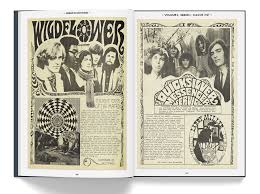
There’s a wealth of photos, many rarely seen, and not just of obscure bands. There are pictures of the Byrds and Buffalo Springfield, for instance, that I don’t recall seeing elsewhere. Also, some of the photographer credits are interesting, such as Ronnie Haran, who booked the Whisky for a while and got the Doors to do a residency there.
Of course, any unfamiliar image of a famous artist is a welcome surprise at this stage, and World Countdown offers many (alas not always with credits, which means negatives are unlikely to be traceable). In particular there are very early images of groups including Quicksilver Messenger Service, Blue Cheer, and Moby Grape (Skip Spence with a perm!), which I’m grateful to Charles Royal for preserving. And the last issue reproduced in the book carries a large number of rare images taken at the Monterey Pop Festival, which are of obvious historical interest. There’s also the only decent image of Tripsichord Music Box I’m aware of.
Some bands that didn’t put out records are detailed, even with a photograph. One interesting example is Flesh & Blood, an integrated group with two drummers, when neither of those attributes were common.
I’ve tried and failed to find out who Flesh & Blood were! Again, there’s a sense of newly formed groups being promoted in ways that larger or more professionally managed publications wouldn’t have been open to. World Countdown is the only place I’ve seen coverage of groups such as Sons Of Adam, Tripsichord Music Box, Crystal Syphon, and West Coast Natural Gas, all of which have gone onto some form of renown. There’s also coverage of non-musical acts such as Congress Of Wonders, whose names will be familiar from gig posters, and tangential figures like Gipsy Boots and Vito Paulekas, which all add to the portrait.
As skimpy on hard data as World Countdown was, some of its contents contain valuable clues. The release date of Love’s Da Capo is usually given as November 1966, but a World Countdown ad clearly states it would be released January 3, 1967.
Yes – the release of Da Capo was delayed, probably so Elektra could market it alongside the first Doors album. Countdown also contains ads for other widely misdated releases, such as Love’s Forever Changes and Captain Beefheart’s Safe As Milk. Reliable information like that is invaluable for pinning down dates.
Some acts from outside North American and the UK got coverage in World Countdown, like the Motions from Holland and MPD Limited from Australia, neither of whom were exactly huge in their homelands. How did World Countdown access this?
A definitive answer is lost in the mist of time, but Charles Royal had business interests in Australia and weird and wonderful contacts elsewhere, so I imagine he was doing favors for like-minded folks – or, perhaps, desperately filling up pages with promotional materials he happened to have to hand.
Some news snippets are intriguing. In February 1967, for instance, there’s a report that Bob Dylan is to sign a $2 million dollar contract with MGM (“$400,000/yr, movie potential unlimited”). In April 1967 the Fugs state they’re expecting their Atlantic album The Fugs Eat It to come out in May (it didn’t), and for them to tour the Orient (they didn’t). And I think this is the first I’ve read of Capitol considering releasing “A Day In The Life” as a single.
Like any newspaper, World Countdown was always on the lookout for a scoop, and contributors like (say) Ronnie Haran and Jerry Hopkins were very much plugged into the zeitgeist. Tales like those, unfounded though they turned out to be, give an evocative sense of pop history unfolding in real time.
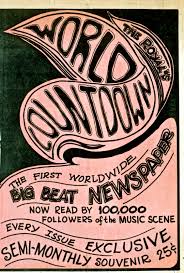
That Fugs feature is mostly flippant and vacuous. Do you find it frustrating that such pieces sometimes couldn’t get useful quotes or info from their subjects?
I do – and they were probably stoned, which doesn’t help. It’s easy to look back and feel vexed that Countdown didn’t feature (say) the Velvet Underground or West Coast Pop Art Experimental Band in depth, because it’s exactly the sort of publication that might have. But at the time, of course, no one knew which obscure acts posterity would be curious about. And, as I said earlier, at this stage of its existence Countdown was more of a collage than a journalistic enterprise.
There aren’t many reviews in this run of World Countdown, but Ralph Gleason’s pieces on Between the Buttons and Surrealistic Pillow are notable. He wrote that Grace Slick “has an uncanny ability to aim her voice like a pistol at a note, hit it true and then let the power expand.” Are there any other phrases that struck you as above-average for what most music journalism was offering at the time?
None spring to mind, but for me one of the pleasures of Countdown is that it doesn’t aspire to literary distinction. (I find early issues of Crawdaddy, for example, all but unreadable because its writers were hellbent on mimicking the adventurousness of the music they were writing about.) By contrast, the sincerity of Charles Royal’s editorial commentary cuts through. For example: “World Countdown advocates that MUSIC is a strong emotional unifying force for good, and if promoted and expanded it will unite peoples of all tribes, languages, colors, countries and circumstances in peace and love.”
Some of the magazine did reprint material from elsewhere, often not bothering to change the typeface and design of the original source. Is it surprising that Royal got away with lifting wholesale from other sources?
World Countdown belonged to the Underground Press Syndicate, meaning it was free to reproduce articles from fellow publications such as International Times, which accounts for many of the non-exclusive pieces it printed. Pinching from Melody Maker was in a different category, but I doubt anyone noticed or cared…
The stylistic coverage of World Countdown is all over the place – maybe more so than any other non-mainstream music paper of the time. Way-underground acts are featured before they made any records, and pretty radical bands like the Fugs and the Velvet Underground are covered too. Yet there’s also attention paid to the likes of Johnny Mathis and Gary Lewis. How do you account for that?
Fundamentally, Charles Royal had set himself the target of producing a reasonably long newspaper every fortnight, so to an extent he had to include whatever he could. Because he was a generation older than most hippies, his own tastes probably touched on mainstream entertainers more than his readership’s did, but I also think he had a genuinely Catholic attitude towards the underground, and believed that music should all be regarded as one broad church. From a historical perspective, of course, his very early evangelizing for almost every significant San Francisco psychedelic group is the most notable aspect of this, but flicking through Countdown does remind one of their context.
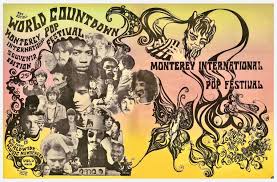
Is there a notable difference in the content and tone of World Countdown post-July 1967?
It never lost its homespun, eccentric charm, but it became more concertedly focused on contemporary underground rock, partly in response to the sheer number of records in that area that appeared post-Monterey. Nor did it broaden its horizons to encompass politics or other countercultural themes common to better-known underground papers of the time – and I for one am glad of that! As an aside, Royal was a family man and a Christian, and although he didn’t use the paper as a soapbox, it entirely omits bad language and sexual content, something that also sets it apart from its peers.
What are the most striking pieces in the issues that postdate the timeframe of this book?
There are interviews with major artists, including one with Neil Young from the time of his first album, and a long piece about Van Morrison from the time of Astral Weeks. In fact, across two issues from 1968 is just about the longest interview I’ve ever seen anywhere, with David Axelrod, and there’s valuable coverage of some of Led Zeppelin’s earliest American shows, as well as in-depth information about groups I’ve seen nothing about elsewhere, such as the Crystal Syphon and Fifty Foot Hose.
Do you intend to publish further World Countdown reprints?
I would certainly like to, but will be led by the response to this volume. My hope is eventually to reproduce the paper’s entire run, which ended in July 1969. That would fill four large books. Unfortunately, however, I’ll need to locate the four issues I’m missing before I can proceed with Volume Three. I’ve been searching for them for many years, and – you guessed it – not only have I never seen or heard of copies, nor has anyone else I’ve communicated with about it. One day…
Info about the book World Countdown August 1966-July 1967 and purchasing a copy is at https://lansdownebooks.com/products/world-countdown.
